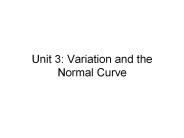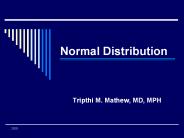Normal Curve PowerPoint PPT Presentations
All Time
Recommended
Title: Unit 3 Summary Statistics (Descriptive Statistics) Author: NRCSE Last modified by: M. Perlman Created Date: 10/4/2000 10:38:00 PM Document presentation format
| PowerPoint PPT presentation | free to download
Formal answer 1: The binomial distribution I ... Formal answer 1: The binomial distribution II. Why is it called the binomial distribution? ...
| PowerPoint PPT presentation | free to view
Suppose a race car speeds along a curve with a constant tangential speed of 75.0 m/s. Neglecting the effects due to the banking of the curve, the centripetal ...
| PowerPoint PPT presentation | free to download
Make sure the diagram shows the area to the left of the desired z score. ... Example 6. The area from some negative z to the mean is 0.4772. Your turn ...
| PowerPoint PPT presentation | free to view
Title: PowerPoint Presentation Author: Plano ISD Last modified by: MSPS Created Date: 8/30/2002 12:24:32 PM Document presentation format: On-screen Show
| PowerPoint PPT presentation | free to view
The Bell Curve Appraisal Method is a performance evaluation technique that uses a normal distribution to assess employee performance. This approach categorizes employees into three groups: top performers, average performers, and low performers. By ranking individuals on a bell curve, it helps identify strengths and areas for improvement while ensuring a fair and objective assessment process. This method is often used in performance reviews, promotions, and salary adjustments, offering a structured way to evaluate talent and foster a productive work environment.
| PowerPoint PPT presentation | free to download
The bell curve in performance management is a method used to evaluate and categorize employees based on their performance. It follows a normal distribution, where most employees fall into the average category, while a smaller percentage are ranked as high or low performers. Typically, the curve divides employees into top performers (high ratings), average performers (middle ratings), and low performers (low ratings). This system is often used in organizations to reward high performers, provide training for average employees, and take corrective actions for underperformers. While the bell curve helps in standardizing evaluations, it has faced criticism for being rigid, discouraging collaboration, and forcing artificial rankings. Organizations adopting this method must ensure fairness and flexibility to maintain employee motivation and productivity.
| PowerPoint PPT presentation | free to download
Chapter 6 Introduction to ... Sampling and the Sampling Distribution Basic Logic And Terminology Samples Sampling Techniques Applying Logic and ...
| PowerPoint PPT presentation | free to view
What is a Bell Curve? A bell curve, or normal distribution, is a statistical graph shaped like a symmetrical, bell-shaped curve. It represents data distribution where most values cluster around the mean, with fewer occurrences at the extremes. Common in performance appraisals, it helps categorize employees into high, average, and low performers. The bell curve is widely used in statistics, finance, and research to analyze trends, predict probabilities, and make data-driven decisions in various fields.
| PowerPoint PPT presentation | free to download
The bell curve in performance management is a method used to evaluate and categorize employees based on their performance. It follows a normal distribution, where most employees fall into the average category, while a smaller percentage are ranked as high or low performers. Typically, the curve divides employees into top performers (high ratings), average performers (middle ratings), and low performers (low ratings). This system is often used in organizations to reward high performers, provide training for average employees, and take corrective actions for underperformers. While the bell curve helps in standardizing evaluations, it has faced criticism for being rigid, discouraging collaboration, and forcing artificial rankings. Organizations adopting this method must ensure fairness and flexibility to maintain employee motivation and productivity.
| PowerPoint PPT presentation | free to download
... do some basic calculations and graphing. Students will think abstractly about the shape of distribution ... curves and shapes of different distributions ...
| PowerPoint PPT presentation | free to view
Estimate the percentage of these men with heights between 63 inches and 72 inches. ... You have to score 1.65 SD above average to be in the 95th percentile. ...
| PowerPoint PPT presentation | free to download
Bell curve appraisal is a performance evaluation method that categorizes employees into different performance levels. This system helps in identifying top performers, average contributors, and underperformers. It enables effective decision-making in talent management, compensation, and promotions, ensuring a fair and data-driven approach to employee assessments and fostering a culture of continuous improvement.
| PowerPoint PPT presentation | free to download
The Normal Curve (continued) NHANES example p.69. Average height of women 18-74 yrs. Old was 63.5 inches (5 feet, 3.5 inches) with SD of 2.5 inches. ...
| PowerPoint PPT presentation | free to download
Chapter 2 DENSITY CURVES AND THE NORMAL DISTRIBUTION Density Curve A graph that represents the relative frequency distribution for a set of data It can be used to ...
| PowerPoint PPT presentation | free to view
Very commonly used in psychological scales, e.g., MMPI. A-scores have mean 500 and SD 100 ... how many entering freshmen will be over 6'6' (78 inches) tall. ...
| PowerPoint PPT presentation | free to view
The area under the curve and above any range of values on the horizontal ... area under the curve is 1 to find the required area under the standard Normal curve.
| PowerPoint PPT presentation | free to download
Linear subdivision. Add a point by local cubic curve interpolation ... Refine other normal for each subdivision. The rule for normal computation ...
| PowerPoint PPT presentation | free to view
Unit 3: Variation and the Normal Curve. Not ... Poisson: life lengths, etc. ... is z = .85. So 80th %ile of scores is [undoing std units] 120 .85(40) 154 ...
| PowerPoint PPT presentation | free to download
5.1 Introduction to Normal Distributions and the Standard Normal Distribution Important Concepts: Normal Distribution Standard Normal Distribution
| PowerPoint PPT presentation | free to view
Letters from the Roman alphabet, such as M and s (for the mean and standard ... Greek letters, ( , s) are used to denote the values of the corresponding ...
| PowerPoint PPT presentation | free to view
Find the mean of this data, to the nearest tenth. ... How many scores fall within one standard deviation above and below the mean? ...
| PowerPoint PPT presentation | free to view
... above and below the midpoint of the abscissa (horizontal axis of the curve) ... symmetrical the mean, median, and mode are all at the same point on the abscissa. ...
| PowerPoint PPT presentation | free to view
Receiver-operator characteristic (ROC) curves considering non-seminoma samples (14) and the normal samples (23) .The ROC curves plot sensitivity versus 1-speci city.
| PowerPoint PPT presentation | free to download
Normal Distribution Normal Distributions A normal distribution is modeled by a bell-shaped curve called a normal curve that is symmetric around the mean.
| PowerPoint PPT presentation | free to view
... Objectives Construction Objectives Vocabulary Normal Curves Properties of the Normal Density Curve Slide 7 Area under a Normal Curve Standardizing a ...
| PowerPoint PPT presentation | free to download
Diagram of Normal Distribution Curve (z distribution) 33.35 ... Assuming the normal heart rate (H.R) in normal healthy individuals is normally ...
| PowerPoint PPT presentation | free to download
Normal Distribution The Bell Curve Questions What are the parameters that drive the normal distribution? What does each control? Draw a picture to illustrate.
| PowerPoint PPT presentation | free to download
Cubic B zier Curve 4 control points Curve passes through first & last control point Curve is tangent at P0 to (P0-P1) and at P4 to (P4-P3) ...
| PowerPoint PPT presentation | free to download
Doo-Sabin Subdivision. MIT EECS 6.837, Durand and Cutler. Doo-Sabin Subdivision. http://www.ke.ics.saitama-u.ac.jp/xuz/pic/doo-sabin.gif ...
| PowerPoint PPT presentation | free to view
Sunday October 5th, * 3-5 PM *, Room TBA: Review Session for Quiz 1 ... Still low resolution (missing fine details) Still have polygonal silhouettes ...
| PowerPoint PPT presentation | free to download
Subdivision: result to which a subdivision process converges ... We will look at several subdivision schemes for converting a control polyloop ...
| PowerPoint PPT presentation | free to view
Normal curves provide a simple, compact way to describe symmetric, bell-shaped distributions. ... If the histogram is symmetric, we say that the data are ...
| PowerPoint PPT presentation | free to download
Congenital curve tibia : 5 cm LLD M. A. Catagni Proximal tibial lengthening Final: knee and ankle normal Congenital curve tibia : 5 cm LLD Proximal tibial lengthening ...
| PowerPoint PPT presentation | free to view
1-To accomplish gradually transition from tangent to the curve. ... F= centrifugal force. SE. b=width. W=mg. Normal Force. Super elevation: SE=Super Elevation ...
| PowerPoint PPT presentation | free to view
For a normal density curve we see the characteristic 'bell-shaped', symmetric ... What height represents the 90th percentile of this aged woman? ...
| PowerPoint PPT presentation | free to download
Approximately 95% of the area under the normal. curve is between x = - 2 and x = 2 ... n 30 the sampling distribution of will be approximately normal. Example: ...
| PowerPoint PPT presentation | free to view
Example: Finding Area Under the Standard Normal Curve From the Standard Normal Table, the area is equal to 0.8276. 1.25 0 z 1.50 0.8944 0.0668 Solution: ...
| PowerPoint PPT presentation | free to view
The Standard Normal Distribution Standard Normal Density Curve The standard normal distribution has a mean = 0 and a standard deviation = 1 Values on the x-axis are ...
| PowerPoint PPT presentation | free to view
Curves. Locus of a point moving with one degree of freedom. Locus of a one-dimensional parameter family of point. Mathematically defined using: ...
| PowerPoint PPT presentation | free to download
To fit curves to a collection of discrete ... Least-Squares Fit of a Straight Line. These are called the normal equations. ... Least-Squares Fit of a Polynomial ...
| PowerPoint PPT presentation | free to download
For distributions described by density curves, we use as the notation of the ... The heights of women aged between 20 to 29 are approximately Normal with mean 64 ...
| PowerPoint PPT presentation | free to view
Bell curve appraisal, also known as forced distribution, is a performance evaluation method that ranks employees into predefined categories based on their performance. Typically, it distributes employees into three groups: top performers, average performers, and low performers, following a bell-shaped curve. This method aims to identify high achievers for rewards and development while addressing underperformance. However, it can be controversial, as it may create competition and affect morale. Proper implementation and communication are essential for its effectiveness.
| PowerPoint PPT presentation | free to download
Normal Distribution A particular family of distributions ( bell curve) Where once you know the mean and the standard deviation you know the distribution
| PowerPoint PPT presentation | free to download
Parametric Curves Ref: 1, 2 Outline Hermite curves Bezier curves Catmull-Rom splines Frames along the curve Hermite Curves 3D curve of polynomial bases Geometrically ...
| PowerPoint PPT presentation | free to view
Continuous Probability Distributions: The Normal Distribution
| PowerPoint PPT presentation | free to download
Bell curve appraisal, also known as forced distribution, is a performance evaluation method that ranks employees into predefined categories based on their performance. Typically, it distributes employees into three groups: top performers, average performers, and low performers, following a bell-shaped curve. This method aims to identify high achievers for rewards and development while addressing underperformance. However, it can be controversial, as it may create competition and affect morale. Proper implementation and communication are essential for its effectiveness.
| PowerPoint PPT presentation | free to download
The bell shape curve Normal distribution FETP India Competency to be gained from this lecture Use the properties of normal distributions to estimate the proportion of ...
| PowerPoint PPT presentation | free to view
The spine is naturally curved. It does not assume a straight line for important reasons. The normal curve of the spine makes sure that your posture and balance is good. This way, it can support your body better. However, there are times when the spine becomes too curved. This condition is normally referred to as kyphosis. This can be harmful to your health because it can lead to breathing difficulties.
| PowerPoint PPT presentation | free to download
Calculating the area under the normal curve. The standard normal table ... Finding Z for a given area: 25% of normal curve lies to the left of what value? ...
| PowerPoint PPT presentation | free to view
Banked Curves Physics 12 Banked ... used when building roads and highways in order to ... Curves Banked Turns Aircraft Banked Turn Slide 4 Road Design with a Banked ...
| PowerPoint PPT presentation | free to view
Deriving the Phillips Curve from AD/AS Derive the Short and Long Run Phillips Curves What shifts the SRPC and the LRPC Short AND Long Term Effects of INFLATION on the ...
| PowerPoint PPT presentation | free to download
Solubility curves Calculations using solubility curves Using The Graph On the Previous Slide 1. Is the solution saturated, unsaturated or supersaturated if there are ...
| PowerPoint PPT presentation | free to view
Normal Distribution MATH 102 Contemporary Math S. Rook Overview Section 15.4 in the textbook: Normal distribution Z-scores Converting raw scores to z-scores ...
| PowerPoint PPT presentation | free to view
Normal Gait Gait is the medical term to describe human locomotion, or the way that we walk. Interestingly, every individual has a unique gait pattern.
| PowerPoint PPT presentation | free to download
























































